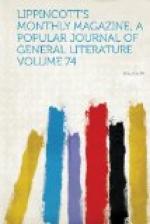We saw the successor of that presumptuous military man next day among the greater and lesser lights that revolve around the throne of Wuertemberg. We ourselves were stationary, crowded into the foremost of the tiers of seats that rose surrounding the immense enclosure, and in the best place for observation, close by the royal pavilion. The hills, bright in the sun and velvet in shadow, made a natural amphitheatre beyond, a little church with its pretty tower looked picturesquely down from a neighboring height, and the whole place was gay with flags and branches, glittering uniforms and gorgeous liveries. We were to see the hohe Herrschaften come in at the farthest entrance and drive around directly before our seats. As the trumpets flourish and the first magnificence sweeps by we hear all about us, “The princess Vera,” and “No, the duchess of Uhra,” and “Is it?” “Isn’t it?” “Which is it?” till we finally settle down to the serene conclusion that it is either one or the other. There is no mistaking the queen, however, with the outriders, six superb black horses and postilions in scarlet and gold. The Majesty herself looks pale and resigned, bending to the right and left in answer to the bows and hochs. Our neighbors “the Weimars” come in full force. A superfluous prince of that family appears to have drifted to these regions, and makes our street aristocratic for us. Young Weimar looks uncommonly well in his hussar uniform, and the old prince and his wife and daughter are resplendent. We met them later that same day in town, but they had taken off their best clothes, and truth compels us sadly to admit that we should hardly have known them.




